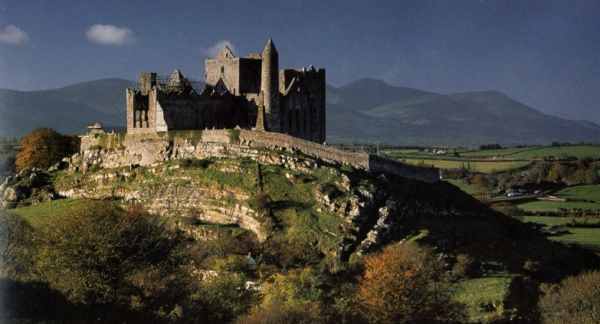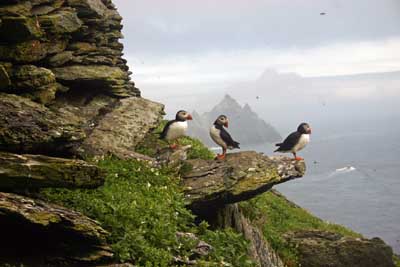
Kilkenny Castle 9:30-4:40, €6/4pp
KILKENNY CASTLE stands dramatically on a strategic height that commands a crossing on the River Nore and dominates the 'High Town' of Kilkenny City. Over the eight centuries of its existence, many additions and alterations have been made to the fabric of the building, making Kilkenny Castle today a complex structure of various architectural styles.
The original Anglo-Norman stone castle was built for William Marshal, 4th Earl of Pembroke (c.1146-1219) during the first decade of the thirteenth century. Kilkenny Castle later became the principal Irish residence of the powerful Butler family for almost 600 years. The Butler ownership began when James (c.1360-1405), 3rd Earl of Ormond, purchased the castle in c.1391, and lasted until 1967 when Arthur, 6th Marquess of Ormonde (1893-1971), presented it to the people of Kilkenny in return for a token payment of £50.

Rock of Cashel €5.30/€3.70pp, 9-4:30pm
It's huge, it's complex, it's iconic, there is nothing like it anywhere
else in the world and it's right here in Cashel at the heart of Tipperary. The Rock of Cashel (Carraig Phádraig), more formally St. Patrick's Rock, it is also known as Cashel of the Kings. Reputedly the site of the conversion of Aenghus the King of Munster by St. Patrick in the 5th century AD. Long before the Norman invasion The Rock of Cashel was the seat of the High Kings of Munster, although there is little structural evidence of their time here. Most of the buildings on the current site date from the 12th and 13th centuries when the rock was gifted to the Church. The buildings represent both Hiberno-Romanseque and Germanic influences in their architecture.
It's huge, it's complex, it's iconic, there is nothing like it anywhere
else in the world and it's right here in Cashel at the heart of Tipperary. The Rock of Cashel (Carraig Phádraig), more formally St. Patrick's Rock, it is also known as Cashel of the Kings. Reputedly the site of the conversion of Aenghus the King of Munster by St. Patrick in the 5th century AD. Long before the Norman invasion The Rock of Cashel was the seat of the High Kings of Munster, although there is little structural evidence of their time here. Most of the buildings on the current site date from the 12th and 13th centuries when the rock was gifted to the Church. The buildings represent both Hiberno-Romanseque and Germanic influences in their architecture.
Blarney Castle €10/8pp, 9am-4:30pm
For over 200 years, world statesmen, literary giants, and legends of the silver screen have joined the millions of pilgrims climbing the steps to kiss the Blarney Stone and gain the gift of eloquence. Its powers are unquestioned but its story still creates debate. Once upon a time, visitors had to be held by the ankles and lowered head first over the battlements. Today, we are rather more cautious of the safety of our visitors. The Stone itself is still set in the wall below the battlements. To kiss it, one has to lean backwards (holding on to an iron railing) from the parapet walk. The prize is a real one as once kissed the stone bestows the gift of eloquence.

English Market, Cork 8am-6pm
Travel counter-clockwise to minimize traffic and see the sunset on the western side


Skellig Rock - Boat trips 10am-3pmThe boat departs daily from Portmagee pier at approximately 10:00am, weather permitting. The boat trip to the Skelligs takes 45 minutes and you have between 2 hours and 2 hours 30 minutes on the rock. The return boat trip lasts a further 45 minutes and you are back into Portmagee at around 3 o clock. It is advisable to book at least 2 days before hand.
The Cliffs of Moher (Irish: Aillte an Mhothair, lit. cliffs of the ruin, also known as the Cliffs of Coher from the Irish: Mhothair) are located in the parish of Liscannor at the south-western edge of The Burren area near Doolin, which is located in County Clare, Ireland.
The cliffs rise 120 meters (394 ft) above the Atlantic Ocean at Hag's Head, and reach their maximum height of 214 meters (702 ft) just north of O'Brien's Tower, eight kilometres away. The cliffs boast one of Ireland's most spectacular views. On a clear day the Aran Islands are visible in Galway Bay, as are the valleys and hills of Connemara.
O'Brien's Tower is a round stone tower at the approximate midpoint of the cliffs. It was built by Sir Cornelius O'Brien, a descendant of Ireland's High King Brian Boru, in 1835, as an observation tower for the hundreds of tourists that frequented the cliffs even at that date. From atop that watchtower, one can view the Aran Islands and Galway Bay, the Maum Turk Mountains and the Twelve Pins to the north in Connemara, and Loop Head to the south.
Moher tower, located at Hag's Head, is a square stone ruin. It appears to be the remains of a watchtower placed during Napoleon's reign in Europe.
The cliffs consist mainly of beds of Namurian shale and sandstone, with the oldest rocks being found at the bottom of the cliffs. One can see 300 million year old river channels cutting through the base of the cliffs.

The Burren is a unique karst-landscape region in northwest County Clare, in Ireland and one of the largest Karst landscapes in Europe. The region measures approximately 250 square kilometres and is enclosed roughly within the circle comprised by the villages Ballyvaughan, Kinvara, Tubber, Corofin, Kilfenora and Lisdoonvarna, It is bounded by the Atlantic and Galway Bay on the west and north respectively. Strictly speaking the territory of the Burren or barony of Burren only contains the villages of Lisdoonvarna, Ballyvaughan, Fanore, Craggagh, New Quay/Burrin, Bealaclugga (Bellharbour) and Carron.
The definite article (making it "the Burren") has only been added to the name in the last few decades, possibly by academics, as it had always been called Boireann in Irish and Burren in English.[citation needed]
Burren is rich with historical and archeological sites. There are more than 90 megalithic tombs in the area, portal dolmens (including Poulnabrone dolmen), a celtic high cross in the village of Kilfenora, and a number of ring forts - among them the triple ring fort Cahercommaun on the edge of an inland cliff, and the exceptionally well-preserved Caherconnell Stone Fort. Corcomroe Abbey is one of the area's main scenic attractions.

Inishmoore Island - Ferry 10:30am, return 5pm, €25 pp
www.doolinferry.com
Phone 353 (0)65 7075555
Dún Aengus
The most famous of the Aran Islands’ prehistoric forts, Dún Aengus sits atop a cliff some 100 meters (330 feet) high on the island of Inis Mór. This popular tourist attraction is of huge
archaeological importance, with historians believing it was built in the Iron Age, and is named after the Celtic god Aengus who features prominently in Irish mythology. The climb to the top of
the slope to view the fort is not for the faint-hearted (nor the elderly or small children), but it is well worth it to see the ruins of this awesome fort.
The most famous of the Aran Islands’ prehistoric forts, Dún Aengus sits atop a cliff some 100 meters (330 feet) high on the island of Inis Mór. This popular tourist attraction is of huge
archaeological importance, with historians believing it was built in the Iron Age, and is named after the Celtic god Aengus who features prominently in Irish mythology. The climb to the top of
the slope to view the fort is not for the faint-hearted (nor the elderly or small children), but it is well worth it to see the ruins of this awesome fort.
If the impressive stone walls of Dún Aengus aren’t enough to impress, the spectacular view of the Aran Islands should convince the visitor that the climb was not in vain, with the expansive Atlantic Ocean stretching to the west and the rocks and stones of the islands to the east.
The origins of the fort are still somewhat of a mystery to historians and archaeologists, although it is thought that it was used for primarily religious reasons and not military, thanks to
its form (which does not include any dwellings or water supply, making it unsuitable for battle or sieges) and its location. Whatever its original purpose, there’s no doubt that today it is
one of the Aran Islands’ top attractions, and the mysteriously romantic fort, the ‘Acropolis of Aran’ is your one must-do during your day trip to the islands.
The origins of the fort are still somewhat of a mystery to historians and archaeologists, although it is thought that it was used for primarily religious reasons and not military, thanks to
its form (which does not include any dwellings or water supply, making it unsuitable for battle or sieges) and its location. Whatever its original purpose, there’s no doubt that today it is
one of the Aran Islands’ top attractions, and the mysteriously romantic fort, the ‘Acropolis of Aran’ is your one must-do during your day trip to the islands.

Galway
Giant's Causeway (natural rock formations), 9:30-4pm

Rope Bridge Carrick a Rede, 10:30-3:30
The Rope Bridge Carrick a Rede is a narrow rope bridge, spanning the strait of 20 meters with a height of 30 meters. Located near Ballintoy, County Antrim, Northern Ireland. This bridge is one of the most popular tourist attractions in Northern Ireland. Walking on this bridge takes approximately 15 minutes, the way, there is a beautiful point of view to stop and enjoy the natural beauty around Rope Bridge Carrick a Rede , At the same time you feel the pounding adrenaline when in the midst of The Rope Bridge Carrick a Rede . This site is owned and managed by the National Trust, which includes two hundred feet and thirty feet above the rocks below. Do you have the courage? Want to test your guts? Visit Carrick a Rede Rope Bridge. feels the sensation that you never imagined before. Your adrenaline will be racing when you will start to cross this bridge and feel the satisfaction when you finish crossing.
Brú na Bóinne Visitor centre is situated on the south side of the River Boyne overlooking the core of the World Heritage Site. It opened in 1997. €6
Dublin

http://www.guinness-storehouse.com/en/Directions.aspx9:30-5pm, €13/10.50

Old Jameson Distillery http://www.tours.jamesonwhiskey.com/Home.aspx
9-6pm, €13/9
Dublin

http://www.guinness-storehouse.com/en/Directions.aspx9:30-5pm, €13/10.50

Old Jameson Distillery http://www.tours.jamesonwhiskey.com/Home.aspx
9-6pm, €13/9







